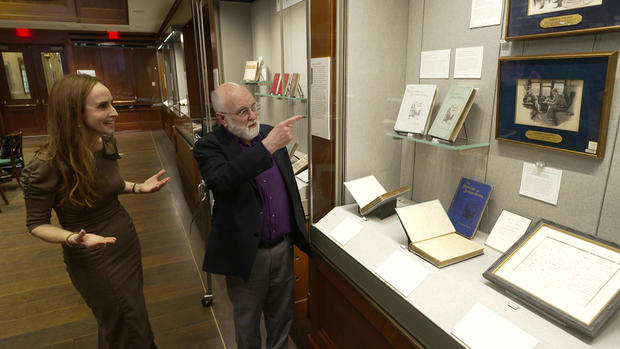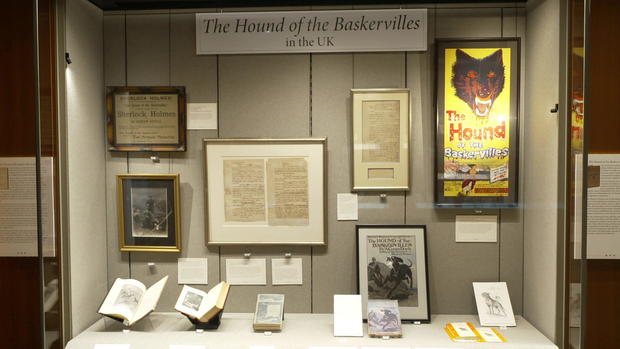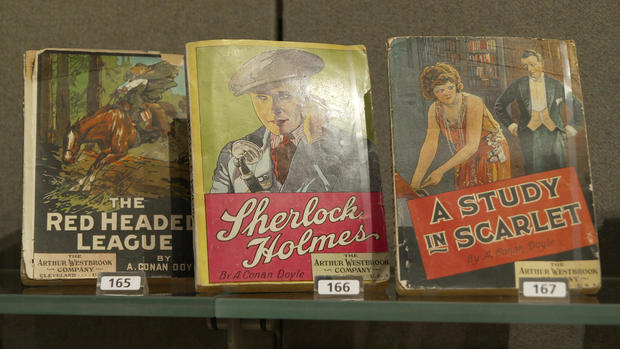It wasn’t easy for Glen Miranker to select what to share from his Sherlockian trove when he and his wife, Cathy, created the exhibit, “Sherlock Holmes in 221 Objects,” now on display at the Grolier Club in New York City. A former executive at Apple, Miranker has amassed a treasure of Holmesiana – first editions, pirated copies, illustrations, and letters – that today comprises about 8,000 objects.
Correspondent Faith Salie asked, “When do you stop?”
“Well, my plan, my hope, is I will stop the day before I die!” he replied.
CBS News
It’s easier to deduce why the Mirankers chose 221 objects: fictional detective Sherlock Holmes and his stalwart sidekick, Dr. John Watson, share a London flat at 221B Baker Street.
And there’s no mystery why Miranker is fanatical about the mercurial detective: “He’s kind of a magical figure,” he said. “He can do things you and I can’t do. He was highly flawed, no doubt a misanthrope, probably a bit of a misogynist. Yet, he spent his life helping people.
“Very large part of what interests me about the items in my collection is, how did this book get written? Why was it written? How much did Conan Doyle make on it? What is the backstory?”
CBS News
Scottish author Sir Arthur Conan Doyle, a doctor by trade, published his first Sherlock Holmes case in 1887. Fifty-nine stories followed. Victorian and Edwardian readers clamored to get their hands on every new installment, said Cathy Miranker.
“People would buy the latest issue of The Strand Magazine at the news shop at the train stations, and they would become engrossed, and they would tumble into the story like Alice falling into the rabbit hole,” she said. “They would look up, and they’d missed their stops.”
CBS News
The “221 Objects” offer a little myth-busting, too. Holmes’ famous quip, from “The Hound of the Baskervilles,” actually reads, “Interesting, though elementary.”
“That may not be the line you remember,” said Cathy Miranker. “You probably remember, ‘Elementary, my dear Watson,’ which actually is not in this story. It’s not in any story that Arthur Conan Doyle ever wrote.”
And now that we’ve cleared that up, how about that iconic hat and pipe? According to Glen Miranker, “Neither the deerstalker hat or the Meerschaum pipe appears in any of the stories. They’re not there. The closest we get is this deerstalker which appears in one of the original illustrations, but it’s not mentioned in the story itself.”
CBS News
The signature pipe was an invention of actor William Gillette, who first played the detective in 1899, and wanted to brandish a big-bowled prop. “So, he wrote to Conan Doyle and said, ‘Do you have any objections if I use such a pipe?’ said Glen Miranker. “And Conan Doyle politely said, ‘You can do whatever you want. I don’t care.'”
Getty Images
Perhaps Doyle’s indifference to Sherlock’s persona had something to do with the fact that he came to resent the popularity of his hero so much that he ultimately threw Holmes over a cliff at the hands of his mortal enemy.
And one of Miranker’s most prized items is Doyle’s written confession: “I have been much blamed for doing that gentleman to death. But I hold that it was not murder but justifiable homicide in self-defence since if I had not killed him, he would certainly have killed me.”
But Doyle never truly succeeded in killing off the old chap. Just ask Glen Miranker.
Salie said, “When you talk about Sherlock Holmes, he sounds like a real person and someone you know?”
“He was a real person,” he replied. “In fact, we’re not even sure he’s not with us still. Surely, he would’ve had an obit if he died! I am convinced at 150, give or take, he’s still with us.”
For more info:
Story produced by Julie Kracov. Editor: Chad Cardin.
CORRECTION: Elementary: Holmes’ companion was Dr. John Watson, not James Watson.



